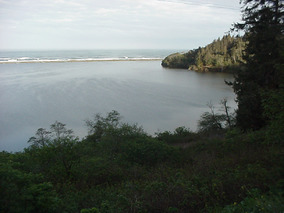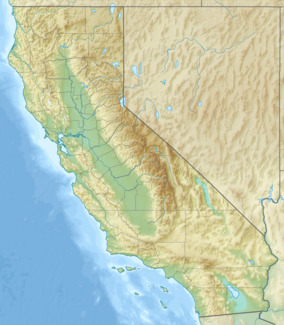| Humboldt Lagoons State Park | |
|---|---|
 Stone Lagoon and coastal bar viewed from Highway 101 | |
| Location | Humboldt County, California, USA |
| Nearest city | Trinidad, California |
| Coordinates | 41°13′50″N 124°6′10″W / 41.23056°N 124.10278°W |
| Area | 2,256 acres (9.13 km2) |
| Established | 1931 |
| Governing body | California Department of Parks and Recreation |
Humboldt Lagoons State Park is on the California coast on the Pacific Ocean, in Humboldt County, Northwestern California. The California state park protects three lagoons with estuaries and wetlands. It is located off U.S. Route 101 between Eureka, and the border with Oregon.
Geography
Big Lagoon is the largest and southernmost lagoon. Stone Lagoon is in the middle, and Freshwater Lagoon is the northernmost and smallest.
The lagoons are shallow bays between rocky headlands where coastal wave action has formed a sandy bar separating each lagoon from the ocean.[1] The 2,256-acre (913 ha) park was established in 1931.[2]
The lagoons are resting areas for migratory waterfowl using the Pacific Flyway between Lake Earl on the Smith River estuarine wetlands 40 miles (64 km) to the north and Humboldt Bay on the Mad River estuarine wetlands 30 miles (48 km) to the south. Studies around Humboldt Bay indicate tectonic activity along the Cascadia subduction zone has caused local sea level changes at intervals of several centuries.[3] The alluvial plain forming each shallow lagoon may support freshwater wetlands or Sitka Spruce forests following uplift events and salt marsh or inundated shellfish beds following subsidence events.
Dry Lagoon
Dry Lagoon, at the southern end of Stone Lagoon, is separated from Stone Lagoon by what may become an island if the sea level rises. Dry Lagoon is presently a wetland representing natural conditions of similar land used for a sawmill near Big Lagoon, or converted to agricultural purposes around the estuaries of Redwood Creek to the north and Little River to the south.
See also
- List of beaches in California
- List of California state parks
References
- ^ "Humboldt Lagoons SP". California State Parks. Retrieved 2012-06-30.
- ^ "California State Park System Statistical Report: Fiscal Year 2009/10" (PDF). California State Parks: 26. Retrieved 2012-06-02.
- ^ "Evidence for Great Earthquakes at Southern Humboldt Bay, California in the Past 3000 years" (PDF). Oregon State University. Archived from the original (PDF) on 2010-06-25. Retrieved 2009-11-10.



